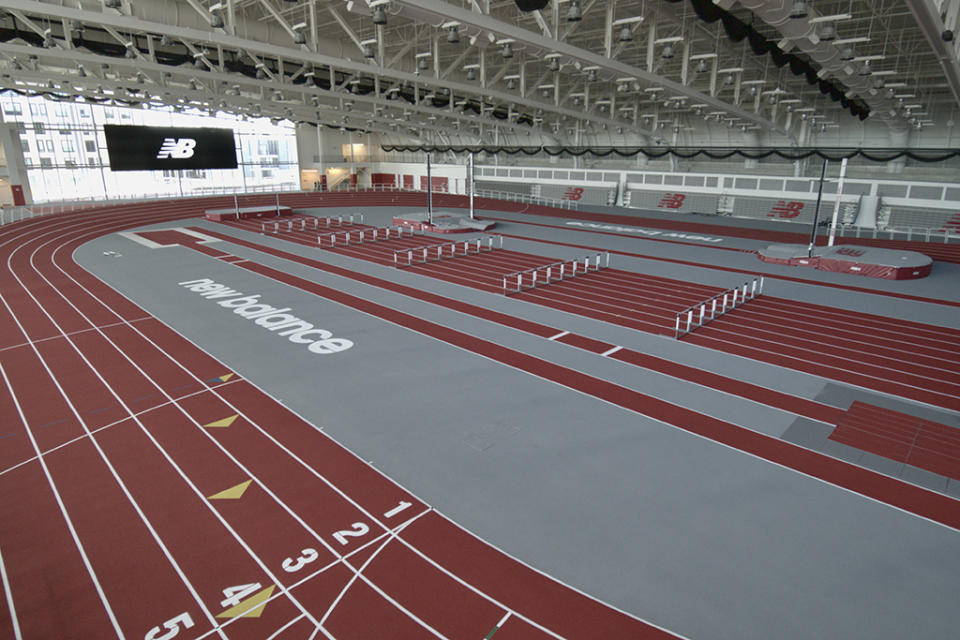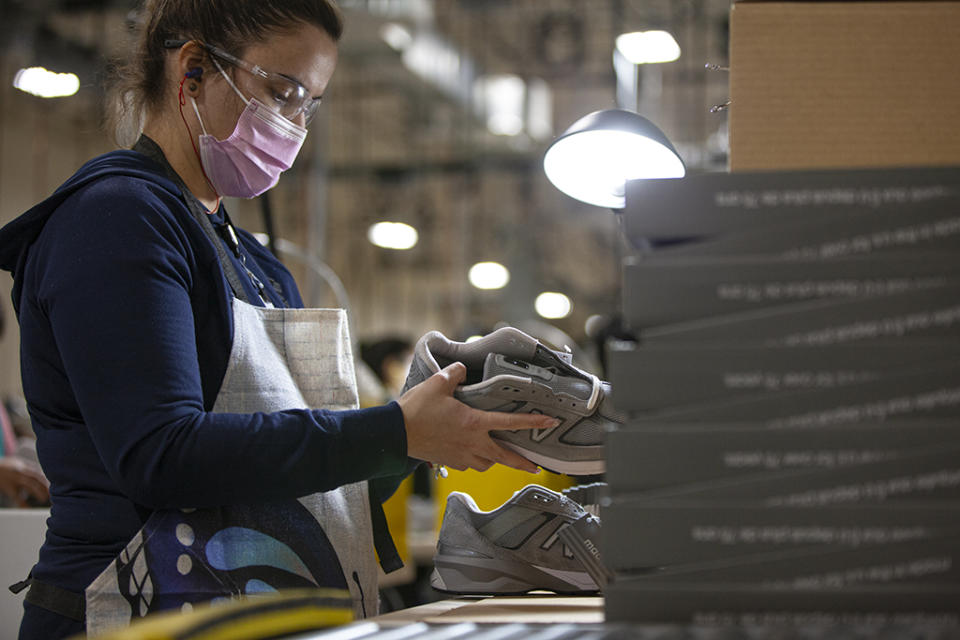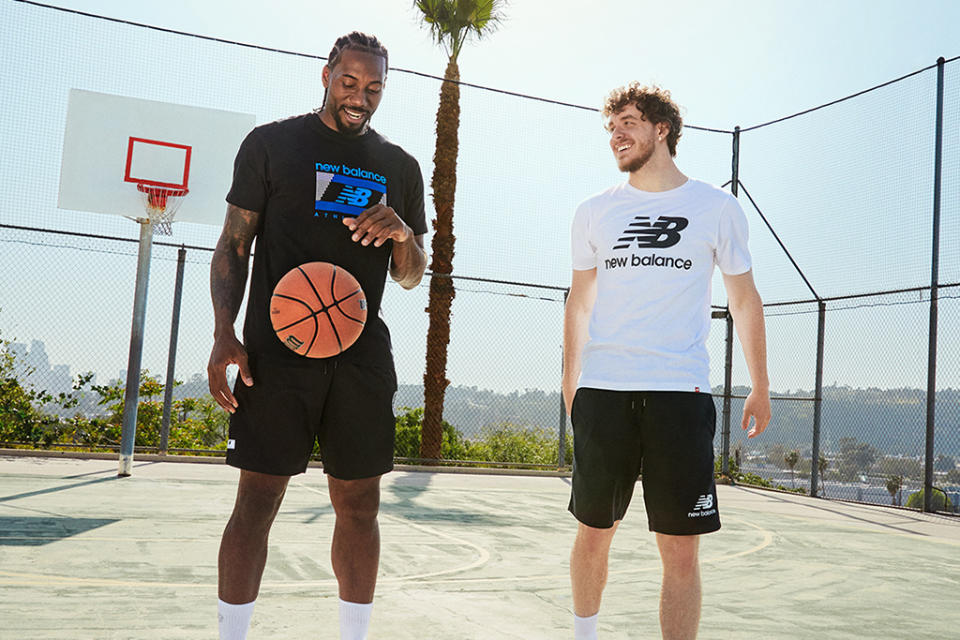New Balance CEO Joe Preston on the Brand’s Resurgence, Commitment to Boston and Domestic Manufacturing

- Oops!Something went wrong.Please try again later.
New Balance president and CEO Joe Preston looks out the windows of his fifth-floor office inside the company’s Boston headquarters, overlooking much of the Brighton neighborhood. He points to a quarter-mile stretch featuring three buildings that formerly served as offices under the ownership of Jim Davis, who purchased the company 50 years ago.
“It’s about community. This is where we started. Community has always been a part of the ownership — [the Davis family lives] about 5 miles from here,” Preston told FN.
More from Footwear News
Bella Hadid Twirls in Sold-Out Crocs With Extreme Crop Top & Baggy Trousers in NYC
Jack Harlow Teases 'Come Home The Kids Miss You'-Themed New Balance 550
Foot Locker CEO Dick Johnson on Hot Brands, Changes in Consumer Behavior & Inflation Concerns
The executive, who has been with the company for 27 years, believes that commitment is a big contributor to the company’s success over five decades, growing from $100,000 in sales in 1972 to $4.4 billion today. “Operating with the values that got us here is an important part of our future,” Preston said. “Making sure we’re an important part of the communities where we operate has been a hallmark of who we are, and an expectation of how we operate.”
The athletic giant’s latest commitment to the community was revealed in April: The Track, a massive multisport facility located across from its headquarters in the Boston Landing mixed-use development. Highlights of the roughly 420,000-square-foot LEED Silver-certified facility include its 19,000-square-foot Sports Research Lab, the 50,000-square-foot Roadrunner music venue and a dual-terrain indoor track with hydraulically banked turns and six oval lanes that are 42 inches wide.
But that’s not the only new addition to New Balance’s local operations. A month earlier, the company opened an 80,000-square-foot athletic footwear factory in nearby Methuen, Mass. The factory, which cost $20 million to renovate, employs more than 90 people and began production in January on the Made 990v5 shoe.
These additions come at a time of resurgence for New Balance. Driven by a desire to own the intersection of sports, music and culture, the brand has recently bolstered its ambassador roster with high-profile talent such rap star Jack Harlow and NBA standout Zach LaVine.
The brand also tapped Aimé Leon Dore founder Teddy Santis last year as creative director of its Made in USA business and has delivered high-heat collaborations with the likes of Joe Freshgoods, Salehe Bembury and others. (In 2020, driven by a seemingly endless amount of hit collabs, New Balance earned FN’s Athletic Brand of the Year honor.)
Below, Preston discusses the company’s health and how it is avoiding being consumed by the industry-wide issues decimating others.
New Balance is competing in more categories than ever before. How do you ensure success across the board?
Joe Preston: “It starts with product, and the people we have building [it] know the category and the consumers, whether that be in baseball where we have about 30% of major league players in our brand, or in basketball and the athletes on our roster — Kawhi Leonard and Zach LaVine as examples — to soccer, where we have two of the top five soccer players in the world: Sadio Mané and Raheem Sterling. People working in those businesses understand what it takes to create product at the highest level. On the lifestyle side, the quality of the product needs to be first and foremost on trend, whether that’s color, materials. And in the past few years, the collaborations have provided great energy. Our lifestyle business is rooted in authenticity. When we talk to consumers, that is where they believe New Balance is strong. It’s about the heritage, the craftsmanship. The 990, that’s 40 years old this year. It was the first $100 running shoe in the industry. When it was introduced, it was the most technical running shoe. As people get in and understand the brand, it’s that authenticity, that craftsmanship that allows us to maintain our lifestyle business.”

Courtesy of New Balance
What do the additions of the Methuen factory and The Track say about New Balance’s priorities?
JP: “We’ve come through COVID stronger as a company. Financially and in the way we operate, the changes we’ve made during COVID have allowed us to move faster. That has been the key to us unlocking the growth we’re experiencing right now. The Methuen factory, we purchased that in 2019. It’s a statement to our commitment to domestic manufacturing. We would have had it opened months earlier if it wasn’t for the supply chain issues that are wreaking havoc throughout every industry. It’s helping us because the demand for our Made in USA product is strong here in the States and all around the globe. We now have five factories and we have plans to expand more in the future. And The Track is the culmination of 11 years of building out Guest Street into a sports hub for Boston and setting a new standard for what the intersection of sport, music and culture can mean. The Sports Research Lab inside The Track is obviously state-of-the-art for track-and-field, but it also is for all other sports. We’ll be able to use those insights to build innovative products, and eventually that can help fuel our domestic manufacturing expansion because we can take data from that and then build customized product with data directly sent into our factories.”

Courtesy of New Balance
New Balance employees returned to the office in March in a hybrid setup. What will return and what has forever been changed in today’s working world?
JP: “People are going to look back and go, ‘You commuted five days a week, an hour each way, and then you traveled 35% of the time?’ I don’t think it’ll go back to that. One of the silver linings from the past two years has been that you can do many things remotely. Things like product meetings, where you’re physically touching the product, that needs to be done in person. Briefing for a season, that can be done virtually. Remote can enhance connectivity. The interactions I had with retailers during my career was mostly in-person, and with many, I’ve had more communication with them over the past couple of years because it’s easier to connect that way. We have teams around the globe, so bringing everybody together virtually is so much more efficient. If it’s used properly, it can help relationships, and I believe that’s the way of the future.”
How has New Balance worked to mitigate the impact of the supply chain backlog?
JP: “We’ve added multiple supply lines overseas to deal with the rise in our growth, as well as to deal with the shutdowns that took place during 2020. When COVID hit and all the stores around the world shut, production dropped off and then it came back, so everybody was trying to catch up, and then you had Vietnam shut down. But during 2020, we added additional capacity, so our capacity today — especially heading into the back half of this year, into next year — is at an all-time high.”
What impact have you seen from the latest lockdown in China?
JP: “A small portion of our production is out of China, so it’s affecting us, but it’s not material. The big issue last fall was the production shutdown in Southern Vietnam, which went on for a couple months. But those factories are up and running, factories overseas are strong right now. The issue is logistics. The structural imbalance within global logistics is creating quite a challenge. Our overall inventory is strong, but we have a disproportionate amount that’s in transit, on ships waiting to be docked at the ports, particularly here and in Europe. It’s much less in the other parts of the world. And once they get in the ports, there is the challenge of the trucker shortage in the U.S. Every retailer is facing that, trying to get goods from distribution centers to their stores.”
How are you addressing price inflation?
JP: “We have selectively raised prices over the past year. You’ve got two issues going on: raw material prices that are rising along with wages, and then you have logistical costs that have skyrocketed and continue to be at levels that are unprecedented. The combination of factors is contributing to higher input costs, and as a result, you have to pass them along. There’s no way around it.”
What is New Balance’s strategy for the back half of 2022?
JP: “We have an exciting new brand campaign [‘We Got Now’] that will be refreshed through the remainder of the year. You’ll see us showing up more in the back half of this year as we increase our spend against those efforts, and you’ll continue to see us build momentum across multiple categories in multiple geographies. At the intersection of sports, music and fashion, we feel there’s opportunity for us to show up. When we do, the brand momentum really elevates.”

Courtesy of New Balance
Best of Footwear News
Celebrate LGBTQ Pride Month With Gear From Brands That Give Back
These Are the Big Mistakes People Make When Shopping for Walking Shoes
Are the New Allbirds Tree Flyer Running Shoes Worth it? We Put Them to the Test.
Sign up for FN's Newsletter. For the latest news, follow us on Facebook, Twitter, and Instagram.

